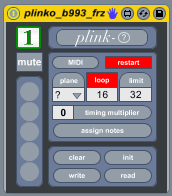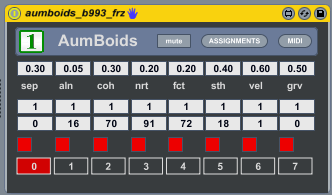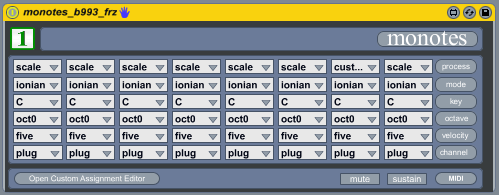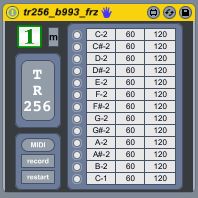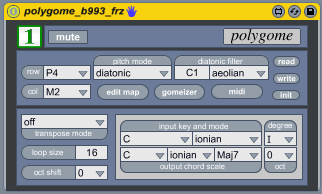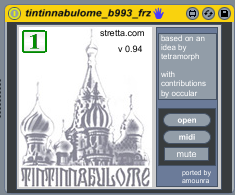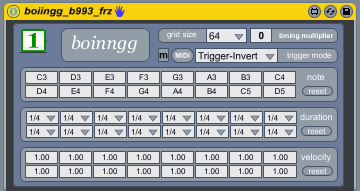Difference between revisions of "Mods"
(→Real Mods) |
(→clipchopper) |
||
| Line 108: | Line 108: | ||
=== [[clipchopper]] === | === [[clipchopper]] === | ||
| − | [[File: | + | [[File:clipchop_pic.png]] |
| − | A highly requested one....so I spent a few minutes (literally....it took about 5 minutes) to port this over to mod-land. Obviously, it can use a bit of work....but I'm pretty sure anything funky going on is NOT due to my meddling. | + | A highly requested one....so I spent a few minutes (literally....it took about 5 minutes) to port this over to mod-land. Obviously, it can use a bit of work....but I'm pretty sure anything funky going on is NOT due to my meddling. |
=== [[help|monomods_help]] === | === [[help|monomods_help]] === | ||
Revision as of 15:37, 17 March 2012
A 'Mod' is just a convenient name for m4l patches designed to be used with Monomodular. They all share at least one thing: they contain a javascript object that communicates directly with the Monomodular Python script, which in turn communicates with Monomodular embedded _Framework control surface scripts. An explanation of how this works, and examples of ways to use certain parts of the javascript, are contained in the Monomods_help patch that is installed in the folder with the rest of the Mods.
Some of the Mods are creations of amounra, while others are ports of Monome patches (mostly Stretta's). Each one will function in an independant way, but they all have several things in common with one another. To learn about the common ground that all plugins share, you should take a look at the How Monomodular Works page. The specifics of each Mod, however, are covered on the following pages that can reached by clicking on the header of each of the following summaries:
Real Mods
monolink
This Mod allows connection to anything that is built for a monome. It formats data back and forth between Monomodular and monome-speak. Consider it as a pure monome wrapper.
plinko
A generative Mod designed to be programmed and manipulated in a Live situation. Each cell on the grid becomes a probability generator, and particles move through the grid with the chance of striking these cells based either on randomness or predetermined paths.
endcoders
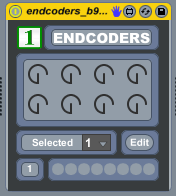 A Livid Code based script designed to easily assign dials to Live's parameters. Adaptable to just about any controller with knobs or encoders.
A Livid Code based script designed to easily assign dials to Live's parameters. Adaptable to just about any controller with knobs or encoders.
binary
A Livid Code based step sequencer which allows easy timing manipulation and polyphonic assignments. Works great as a timing engine for other Mods, as well.
life
A rhythmic sequencer based on a jitter implementation of Conway's 'Game of Life' rules.
aumboids
Experimentation with flocking behaviour in javascript. Judges distance between agents and sends out as controller data, while triggering notes based upon arbitrary relationships between individual agents and their leader.
monotes
A simple triggering device that allows assignment of the grids keys to different notes and MIDI/Nome channels.
swing16
Barely a Mod, this one just allows Device Controllers to lock to the swing parameter of all the instantiated Mods (if they have swing capability).
loopmaster
A Mod capable of controlling four instances of the tape-based looper, MaxLooper. It allows recording controls and manipulation of those loops with the Mod grid.
TR256
16 step rhythm sequencer. Capable of holding 16 patterns, recording real-time MIDI input, and editing patterns on the fly. Thank you, Stretta.
pressCafe
16 step rhythm sequencer. Just, well, 'rad'. Thank you, Stretta.
polygome
Um....polyphonic rhythmic whatchamadoohicky that sounds really cool and is way fun to play. It does everything. Except my dishes. REALLY, thanks Stretta.
tintinabulome
Polyrhythmic mother ship. A bunch of guys came up with this one....Stretta was involved.
sment
Um. Stretta.
boiingg
Ok, this is just good clean fun. Nodes bounce up and down depending upon how high you drop them from. When they hit the bottom, it makes a sound.
grainstorm
More Stretta, this one a new one built for the Arc. I've ported it to work with the Code/c all inclusive, or you can use any grid for manipulation. This one is still very young.
xor
Tehn's xor. A very quick port that is fairly self explanatory if you check out his docs. Lots of fun!
clipchopper
A highly requested one....so I spent a few minutes (literally....it took about 5 minutes) to port this over to mod-land. Obviously, it can use a bit of work....but I'm pretty sure anything funky going on is NOT due to my meddling.
monomods_help
This is where you start if you want to build your own patches, or just to see how the Monomodular framework is built on the Max side of things.
Other Patches contained in the Monomodular suite
NomeOut
A very useful patch for routing things in Live, since they didn't give us the capability to direct things with reasonable and predicable latency within m4l. If you have a Mac, you should probably use IAC, but that being said, I run on OSX and I still use Nome a bit here and there.
MaxLooper
A tape-based looper. It provides visual output to the LCD patch, so that you can display loop data HUD style on your computer, or in the Lemur AumPad/256 LCD screen. It's of little use to anyone but its writer currently, since it's built around a custom pedal that connects to the expansion port of an OhmRGB and is, well, still a work in progress besides. That said, it hasn't crashed in over 2 months, so it is at least stable at this point if still not quite 'in-time, all-the-time'.
LCD
The current implementation of LCD requires only one patch, and autoswitches between all supported and installed devices based on which one is currently being operated. In addition, it supports output to the Lemur AumPad and Aum256 templates.
AumPad and Aum256
These patches serve to link together the Python scripts and the iPad via OSC. They are necessary to provide a UDP connection to the AumPad/256 and LemuarPad/256 scripts, as well as translate some things that are sent back and forth.

